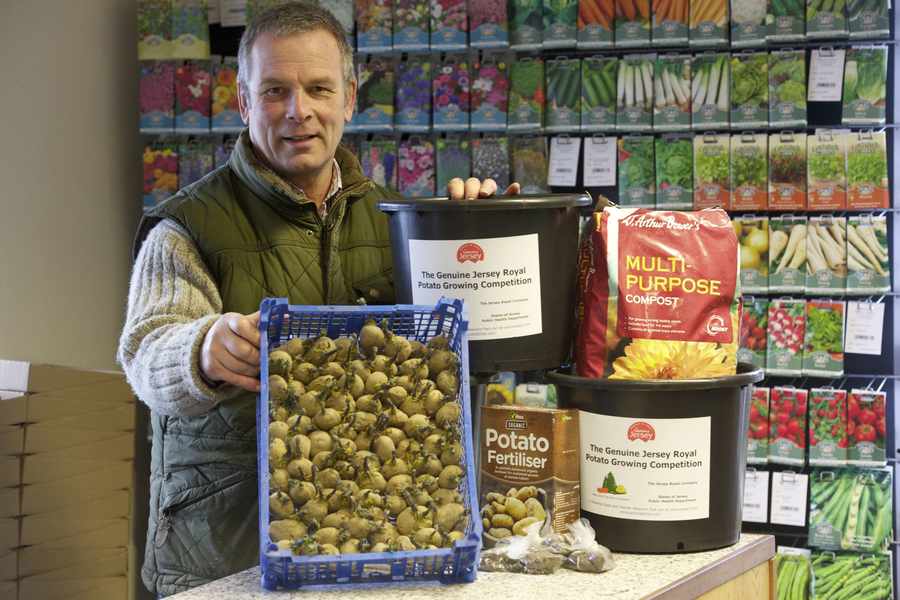Yes, the Genuine Jersey Potato Growing Competition is back for its ninth year, with 32 Island schools as well as Constables, media staff, WI members and Jepson the bear all taking part to see who can grow the heaviest crop and the most tubers.
The plants will need light, water, food, space, air and the correct temperature to grow well:
- Light make sure the container is placed in a well-lit area with good air movement and space
- Water after the initial watering when planting the potatoes, ensure that the soil is damp, which may mean watering every three to four days. But do not over-water or they will go mouldy.
- Food this comes from nutrients in the compost, but if you add some extra plant food read the instructions carefully.
- Temperature the ideal temperature for growing potatoes is 10 to 15°C. [figure title=”6912458″ align=”none” url=”/?attachment_id=1120037″ id=”1120037″ size=”25″]
The event has been organised by the Genuine Jersey Products Association and supported by the States of Jersey Health Department and the Jersey Royal Company.
For the past four years Belles Fleurs Nursery and Garden Centre in Grouville, run by husband and wife team Bernard and Martine Rebours, have been funding and supplying the ingredients and buckets.
At the last count the nursery had sorted out 275 buckets, each containing a bag of organic fertilizer, polystyrene cubes for drainage, 15 litres of compost – and two sprouted seed Jersey Royal potato tubers, supplied by the Jersey Royal Company, to complete the kit.
‘They’re just about all ready to go,’ said Bernard, who still had a few Genuine Jersey stickers to place on a stack of buckets.
‘We’ll be delivering them next week to the 32 schools, the Constables, the media and the WI.’
The major task of putting the kits together started some weeks ago and Bernard and the staff have organised the buckets, sorted out the polystyrene cubes and bagged up the fertilizer and everything else, in between running the business.
But Bernard believes that the competition is a great idea and particularly educational for the schoolchildren taking part, who benefit for a number of reasons.
‘I think it’s important that they know where their food is coming from,’ he said. ‘It helps them understand local agriculture better and shows how they can grow potatoes.
‘I believe some of the schools will cook the potatoes afterwards, so the kids will be able to taste them, too.’
Offering some tips to get the biggest and best crop, Bernard advised not to over-water in the early stages, keeping the potatoes free of pests and diseases, and two weeks before they’re ready to harvest making sure you water well to swell the tubers.
Last year the Constable of St Clement, Len Norman, grew the heaviest crop, while his St Saviour counterpart, Sadie Rennard, grew the most tubers.
The media winners were ITV Channel who were top in the heaviest crop section and Connect magazine who won the prize for the most tubers.
All the competitors will be judged at the end of May, as part of the Jersey Food Festival.

Jobs For The Week

- Check shrubs and climbers in containers in rain-sheltered spots they may need watering
- Cut back buddleias and lavatera drastically. They produce their best show of flowers on wood made from spring onwards, so by cutting them you should encourage plenty of new growth
- Using sharp secateurs, clip faded flowers on winter-flowering heathers in pots and in borders
- Continue to deadhead winter-flowering pansies and pom-pom daisies
- Make sure seedlings growing indoors are getting plenty of natural light or they will become leggy
- Sow sweet peas as soon as possible
- Keep off the grass if its icy or frozen
- Continue to dig over the soil of your vegetable garden, forking in plenty of bulky organic matter in preparation for the new season
- In mild weather, hoe and pull up weeds, to stop them taking a hold in summer

THIS easy-to-grow, reliable shrub gives a burst of colour in mid-winter, thanks to its bright yellow tubular flowers which appear on bare stems.
- Growing to three metres (ten feet) in height and spread, it can be trained against a wall or fence, or just left to make an informal clump.
- Dont neglect it for too long or it will become a tangled mass that youll have to cut down to the ground in spring.
- Keep it in check by cutting out most of the stems that have borne flowers when flowering finishes in April.
- Winter jasmine prefers to be planted a sunny site in humus-rich, well-drained soil.
Ask the Expert

Francis Le Quesne, proprietor of Le Quesne’s Garden Centre, answers your horticultural questions
Q: Is it time to start sowing my veg seeds, like lettuce, tomato and beetroot?
A: You are still a little early. Late February to March is the usual time for these things. However, if you are confident we are going to have a good spring, things like lettuce can be grown under glass and then planted outside under a small poly tunnel. Carrots, beetroot etc are better sown directly into the soil outside. Leave these until the soil has started to warm up in March. Things like tomatoes and peppers are best started off under glass and only planted out in June when the weather warms up. Don’t be tempted to rush things – most veg will come up more quickly when sown in warm soil.
Q: The pots on my doorstep need revamping for the spring. I think I am too late for early bulbs – any suggestions?
A: People live busy lives and it’s easy to miss the slot when bulbs should be planted. To this end, garden centres now sell more bulbs growing in small pots for planting out than dry bulbs. There are still nice primroses and violas available with which you can make nice mixed pots of spring-flowering plants and bulbs – instant gardening, but very effective.
Q: We bought a pot grown Christmas tree and planted it out in the garden in mid-January, but it has now lost most of its needles. Why has it done this, and will it recover?
A: Your tree had acclimatised itself to a warm living room and had quite a shock when it went outside. It is always best to do this gradually. Sit it in a garage or shed for a week to adjust. You may be lucky in the spring and it will recover, but will take a year or more to fully recover and green up evenly.

THE gardens of Château La Chaire in St Martin feature in a photographic exhibition that is currently on view at the Garden History Museum in London.
The exhibition, called Faded Glory, is by Rachel Warne who photographs gardens which were once grand but over the years have been left untended and grown wild. It was Victorian horticulturist Samuel Curtiss who lived at Château La Chaire and created the gardens, and part of the exhibition will include one of the original diaries of Charles Fletcher who owned La Chaire from 1898 to 1907.
Rachel spent a weekend photographing La Chaire last year along with Stephen Harmer, a landscape designer and lecturer at Hadlow College, who chose the gardens as the subject of a dissertation and wrote his first book, La Chaire, The Story of Jersey’s Lost Garden.
Rachel’s intention in the exhibition is to raise awareness of these lost gardening gems, but also to see the wilderness of these gardens in a positive way and to imagine just how beautiful and grand they must have once looked.
The exhibition runs until Sunday 1 March.
I HAVE to admit that at this time of year I’m tempted to carry out a form of gardening that requires little energy and even less exposure to cold northerly winds.
I call it ‘armchair gardening’ and it consists mainly of delving into my box of gardening books to see what I should or would be doing if I were brave (or foolhardy) enough to put my nose out of the door for even five minutes.
Somewhere in the shed are several packets of sprouting seeds. So I should, once I find them, rinse out a couple of jam jars and start the sprouting process in the airing cupboard. It takes only a few minutes and in a few days’ time I would have extra salad at no extra expense. But as I said, I would have to go to the shed first. That means putting on a coat and boots and heading into the wind and sleet.
Another job I should be getting on with around now is sorting out the various cloches, pop-up cold frames and mini greenhouses that will warm the soil and enable early seedlings to put on growth. Over the years I’ve accumulated a goodly number of these anti-frost protection tools and they really are worth the bother. Unfortunately, over the mists of time, the instruction leaflets for assembling these contraptions have become lost, or buried under several stacks of flower pots. On occasion I’ve even been known to buy the same piece of equipment twice, purely in order to obtain the instructions for the one I’ve already bought.
Unfortunately, with these northerly winds likely to blast in for some time to come, I’m loath to try and put up anything that might simply blow away with the next puff of wind. In any case, I’d have to go out to the shed.
Much easier, should I be tempted to start planting a few peas, beetroot or radishes in a sheltered, well-groomed spot out of doors, is the use of horticultural fleece. I buy mine by the roll and keep the growing spaces nice and small, as the fleece does tend to blow about a little while you’re trying to plug it down around the edges with some clods of earth. Given that the winds last weekend varied from Force 5 to Force 7, I decided this particular job was one to put in the pending tray until next week.
I did, of course, intend to pop in to the allotments on Sunday, just to make sure nothing had blown away in the Force 8 we had the other night. Unfortunately, just as I was driving past the entrance, the rain started pelting down again. I decided I’d come back later.
Daydreaming about all this effort is giving me quite a thirst. Time to put the kettle on while I reread the instructions for sowing under cover …






